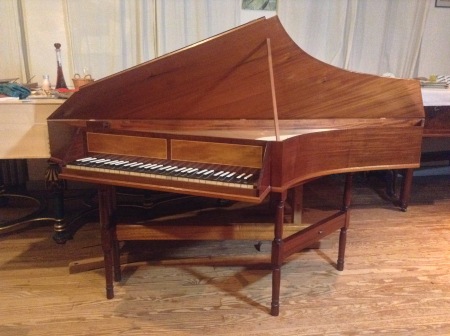Skowroneck harpsichords: sales
Updated March 5, 2024.
This page contains sales offers of various instruments. Current offers are listed first.
Further down on this page you will find information about how to find the signature on Martin Skowroneck’s harpsichords, and a short text about beryllium-copper strings.
This page is about the keyboard instruments made by Martin Skowroneck, who was a harpsichord and recorder maker and my father. Skowroneck made 89 harpsichords, three fortepianos and a great number of spinets, virginals and clavichords between the mid-nineteen-fifties and 2013. His last Franco-Flemish two-manual harpsichord No. 90 was completed in 2019 by Dietrich Hein in Oldenburg.
These instruments were all hand-made to the very highest standards.
If you have questions, please send me an e-mail
tilman[at]skowroneck[dot]de (replace the “at” and “dot”)
Current offers:
English Bentside Spinet (1968), compass GG-f”’ (transposing keyboard 415-440-460Hz. arranged in 2015 by Gregor Bergmann)
This is one of altogether four spinets in this style made by Martin Skowroneck. This instrument has always been in our family and was Skowroneck’s particular favorite among all his instruments. Beryllium-copper strings (see also the text below on this page). Ivory-covered sharps. An official CITES document (for the ivory) does exist and is part of the purchase.
Price 12 000,- €





How to find the maker’s signature in Martin Skowroneck’s instruments
Martin Skowroneck’s recorders and flutes have the superimposed letters M and S stamped on, and often also a stamped number.
Early (1950s–early 1960s) keyboard instruments usually bear a signature on the soundboard.
Later small keyboard instruments have the signature under the keys, as can be seen in the picture of the interior of the spinet offered further above. The same applies to the three fortepianos he made.
Later–than–early–1960s harpsichords have their signature, date and serial number invariably handwritten not visible behind the nameboard. Often the latter can be detached by means of taking out a few screws or turned wooden knobs. In some styles of harpsichords one would have to unscrew the stop levers first in order to slide the nameboard upward for a look.
Beryllium copper is not the same as Phosphor bronze:
Instead of brass, Skowroneck used beryllium copper strings. Unfortunately, this material comes in a variety of qualities, and some of it does not sound very well. I have, however, mostly good experiences with the specific wire used in the Bremen workshop. In fairness, it should be noted that Martin Skowroneck did see this material as a (good) compromise. He regularly tested various kinds of brass, but was not satisfied with the material available during his lifetime. This knowledge may prevent owners from making rash and costly decisions regarding replacements.
1) This modern material, which has a breaking point similar to brass, has one positive mechanical property similar to historical brass: it sets quickly instead of stretching endlessly. A replacement string will keep its pitch after only a few adjustments.
2) Other advantages include a relatively high resistance to breaking when bent, and a complete absence of the annoying tendency of modern brass to slip at the loops.
3) Contrary to occasionally voiced beliefs, beryllium copper is also not prone to material fatigue and deterioration during normal use in the appropriate sections of the instrument (that is, if the scaling and pitch are appropriate for this material). The sound stays largely the same for decades, and the tendency to break does not increase noticeably (unless a string is, of course, faulty from the start). I did, however, have to wipe the strings in one of my clavichords (from the mid 1970s) with a bit of soft-but-sturdy cork recently, in order to get rid of some accumulated dust. This opened up the sound again.
4) Beryllium copper of the kind best known to me also has a, dare I say, appropriate sound for its task. I have had the opportunity to test both brass and beryllium copper in one single instrument, monitoring the properties of both materials over a time span of 15 years during which the instrument was intensely used in performances. I found beryllium copper to sound slightly “fuller” than the brass that is usually available today, but without compromising the appropriate overall “brassy” sound character.
In view of the properties listed above I personally prefer this material over brass (Stephen Birkett has now started to make historically-informed brass, but I have not yet received any samples). But it needs to be said again: the sound of beryllium copper may vary from manufacturer to manufacturer and not all of it appears to be as good as I describe it here.
The reason for this lengthy explanation is that beryllium copper looks very much like phosphor bronze, and can easily be mistaken for it. The point is that phosphor bronze harpsichord strings are indeed inferior to both brass and beryllium copper, so there are good reasons to be wary when encountering copper-colored strings. But the looks alone are insufficient for a proper identification.
In fact, not a single Skowroneck harpsichord was ever delivered with phosphor bronze strings. It would be a shame and a waste of good material to change the red strings found in a used Skowroneck harpsichord into new brass strings on the basis of such a misunderstanding.
October 23, 2013 at 10:54 pm |
love your article on voicing! If only more builders/servicers would dare use feathers! best regards, martin spaink